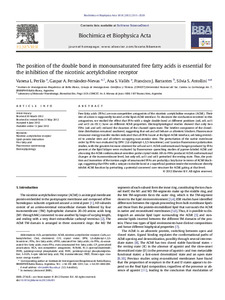Please use this identifier to cite or link to this item:
https://repositorio.uca.edu.ar/handle/123456789/8767| Título: | The position of the double bond in monounsaturated free fatty acids is essential for the inhibition of the nicotinic acetylcholine receptor | Autor: | Perillo, Vanesa L. Fernández-Nievas, Gaspar A. Vallés, Ana Sofía Barrantes, Francisco José Antollini, Silvia S. |
Palabras clave: | RECEPTORES; PROTEINAS; LIPIDOS; COLESTEROL; ESPECTROSCOPIA; ELECTROFISIOLOGIA | Fecha de publicación: | 2012 | Editorial: | Elsevier B.V. | Cita: | Perillo VL, Fernández-Nievas GA, Vallés AS, Barrantes FJ, Antollini SS. The position of the double bond in monounsaturated free fatty acids is essential for the inhibition of the nicotinic acetylcholine receptor. Biochimica et Biophysica Acta. 2012; 1818. https://doi.org/10.1016/j.bbamem.2012.06.001. Disponible en: https://repositorio.uca.edu.ar/handle/123456789/8767 | Resumen: | Abstract: Free fatty acids (FFAs) are non-competitive antagonists of the nicotinic acetylcholine receptor (AChR). Their site of action is supposedly located at the lipid-AChR interface. To elucidate the mechanism involved in this antagonism, we studied the effect that FFAs with a single double-bond at different positions (ω6, ω9, ω11 and ω13 cis-18:1) have on different AChR properties. Electrophysiological studies showed that only two FFAs (ω6 and ω9) reduced the duration of the channel open-state. The briefest component of the closed-time distribution remained unaltered, suggesting that ω6 and ω9 behave as allosteric blockers. Fluorescence resonance energy transfer studies indicated that all FFAs locate at the lipid-AChR interface, ω6 being restricted to annular sites and all others occupying non-annular sites. The perturbation of the native membrane order by FFAs was evaluated by DPH (1,6-diphenyl-1,3,5-hexatriene) and Laurdan fluorescence polarization studies, with the greatest decrease observed for ω9 and ω11. AChR conformational changes produced by FFAs present at the lipid bilayer were evaluated by fluorescence quenching studies of pyrene-labeled AChR and also using the AChR conformational-sensitive probe crystal violet. All cis-FFAs produced AChR conformational changes at the transmembrane level, but only ω9, ω11 and ω13 perturbed the resting state. Thus, the position and isomerism of the torsion angle of unsaturated FFAs are probably a key factor in terms of AChR blockage, suggesting that FFAs with a unique cis double bond at a superficial position inside the membrane directly inhibit AChR function by perturbing a potential conserved core structure for AChR gating at that level. | URI: | https://repositorio.uca.edu.ar/handle/123456789/8767 | ISSN: | 0006-3002 | Disciplina: | MEDICINA | DOI: | 10.1016/j.bbamem.2012.06.001 | Derechos: | Acceso abierto | Fuente: | Biochimica et Biophysica Acta Vol. 1818, N° 11, 2012 |
| Appears in Collections: | Artículos |
Files in This Item:
| File | Description | Size | Format | |
|---|---|---|---|---|
| position-double-bond-monounsaturated.pdf | 811,4 kB | Adobe PDF |  View/Open |
Page view(s)
174
checked on Mar 31, 2025
Download(s)
178
checked on Mar 31, 2025
Google ScholarTM
Check
Altmetric
Altmetric
This item is licensed under a Creative Commons License

